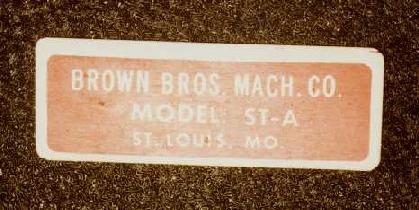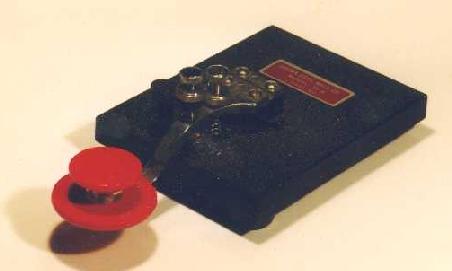Brown Brothers Machine Company Keys


By Jim Zimmerman, KG6VI -- Reproduced from the Vail Correspondent No. 2 January 1993
The purpose of this article is to describe in detail the Morse code keys made by the Brown Brothers Machine Company (BBMC), to aid the serious key collector in identifying each model made by this fine company.
The BBMC never made keyers, only keys. The keys were all hand-made by one person, Bill Brown. Bill made the die-cast machine and all the key parts and dies himself. He also designed, painted and labeled each key ever made by the BBMC. Bill worked alone making the keys in his basement shop. He was a real craftsman and a true perfectionist.
The BBMC made their line of keys from 1964 to 1979. In this time they produced ten different key models. All of the BBMC keys are easily recognizable by their distinctive black, wrinkle-finish, metal bases, bright red plastic paddle/knobs, red/silver nameplates and chrome plate hardware. Mr. Ed Brown once told me that he always thought of Christmas ornaments (red, silver, chrome, and black) when he saw the BBMC keys. Ed was a "silent partner", the company's financier and idea man; Bill was the hands-on key maker.
BBMC keys did not have serial numbers, like their Vibroplex counterparts, but did have their model type on the nameplate. The nameplates were small, rectangular metal plates, measuring about 0.5 by 1.5 inches. These nameplates were glued on to the keys (except for the unbased models UTL, UTL-A) in various locations. The key nameplates said: Brown Bros. Mach. Co./Model xxx-x/ St. Louis, Mo. There seems to be slight differences in the lettering sizes, but this does not give any clues as to manufacturing dates.
The BBMC keys were sold both by mail and in stores in small cardboard boxes. The boxes had a red/white label on one end proudly stating "Brown Keys" with the enclosed key model stamped in black ink. The model CTL keys {Combination twin lever paddle / straight key) were shipped with the straight key leads shorted with a wire lead / string tag. No key travel cases or keying leads were ever made by the BBMC. The BBMC paddle keys were constructed to allow the operator to assemble the keys's two paddles in three different spacings to suit the operator's preference.
I've put together a summary of all ten key types in Table 1. To obtain the year each key model was introduced and its original cost, I researched my files of QST magazines for advertisements, and BBMC literature.
Beginning key collectors are occasionally fooled into buying BBMC look-alike keys made by a company called "Ham-Key", also out of St. Louis, MO. Despite numerous similarities between the BBMC keys and the Ham-Key keys, they were made by two separate companies. I have included in Table 1 cross referenced key models for the Ham-Key line for the collector's reference.
The BBMC keys were identified by their model names; three letters followed by a series letter (example: "CTL-B"). The characteristic "twin lever" (TL) vertical shaft pivot mechanism was later replaced by the leaf spring on the paddles to provide a better circuit path for keying, but the letter designation remained. The model names were derived from the following:
UTL = unbased key, twin lever paddle BTL = based key, twin lever paddle ST = straight key CTL = combination key, straight key/TL paddle CSA = combination key, straight key/bugThe model UTL was a base-less paddle mechanism designed to be sold to the do-it-yourselfer to attach to a favorite base/keyer. These models are identified by a smaller nameplate that simply said "Brown Bros." mounted on the front top of the key frame, facing the operator. this model key was later used in the Palomar Engineering "IC Keyer", first introduced in 1969.
The model BTL was the BBMC's original keyer paddle which used the UTL on a heavy, black painted, wrinkle finished, metal base. The key leads connected through three screw terminals located on a recessed panel mounted on the key"s rear (away from the operator). The BTL , and the other BBMC key models, were first reviewed as "New Apparatus" in the September 1964 issue of QST magazine.
The ST was the original straight key of the BBMC line. It used a conventional pivot mechanism to give the make-break key switch action. Connections to the transmitter key jack cable was through two rear-mounted , screw-type terminals. The key's knob was a Navy style (with skirt) , in the usual bright red color.
The model CTL was the combination of two keys, the UTL and the ST, on a single base. This base was coincidentally the same size as that used for the BTL, only rotated 90 degrees. The key leads were made through the usual screw connections mounted on the key base's rear. The two keys could be connected separately to two different rigs if the operator desired.
The rarest of the BBMC keys is the model CSA. This was a combination bug and straight key on a common base. Only a few model CSA's were ever made by BBMC due to the growing popularity of automatic keyer/paddles. (BBMC kept no records of the number of each model key manufactured.)
The model UTA-A was an improved version of the UTL, with a leaf spring mechanism replacing the two paddle pivots. The key paddles and colors of the origianal UTL were retained. This model was first introduced in 1974 , along with models BTL-A, CTL-A, and ST-A.
The model BTL-A replaced the earlier BTL paddle with a UTL-A paddle mechanism on a slightly smaller metal base. This model is most often confused with the similar Ham-Key model HK-1 paddle. They may physically resemble each other, but the operation and feel of the two paddles are quite different. The BTL-A mechanism was officaially patented on 4 September 1973.
The model CTL-A was a model CTL with a model UTL-A replacing the original UTL. I found this model key first shown in a 1974 QST ad for the HAL Communications model 1550 keyer. (The CTL-A was not included in the price of the HAL model 1550 , but later HAL ads did show and offer an optional HAL "FYO" paddle.)
The model ST-A was an upgraded model ST straight key that used the UTL-A's leaf spring for the key's pivot mechanism, to replace the earlier coil spring. When used, these keys make an unusual, higher-pitched sound that is unique for straight keys. Speaking of other straight keys, the model ST-A look-alike was the HamKey model HK-3 straight key (although the HK-3 had a trunnion pivot mechanism). As a purely personal observation, I would say that the BBMC model ST-A has the smoothest feel of any straight key I've ever had the pleasure to use. This was an opinion felt by many operators that I tried to trade out of there model ST-A keys, which made it tough to get one!
The final model BBMC key was the model CTL-B. This model was created from the CTL-A by replacing the model ST straight key with a ST-A straight key. Now both the paddle and the straight key had the leaf-spring mechanism. This key combination was sold from its introduction in 1976 'till 1979. After that , the BBMC key production ended. As before with the model BTL-A and ST-A, the Ham-key Company made a look-alike to the CTL-A key, their model HK-4.
Information that I received from Palomar Engineering states that they never had a keyer's BBMC key mechanism come back to them, a tribute to the workmanship of Bill Brown. The lasting beauty and great feel of his keys continue to prove their worth as timeless pieces of classic ham gear.
Model Year Cost Size(in.) Type HK copy BTL 1964 14.95 3.5X4.5 pivot --- CTL 1964 18.95 4.5X3.5 pi/pi --- ST 1964 6.95 3.5X4.5 pivot --- UTL 1964 10.95 NA pivot --- CSA 1964 20.95 4.5X3.5 pivot --- BTL-A 1974 30.75 3.5X3.5 leaf HK-1 CTL-A 1974 32.95 4.5X3.5 pi/lf --- ST-A 1974 15.95 3.5X4.5 leaf HK-3 UTL-A 1974 23.95 NA leaf HK-2 CTL-B 1976 36.95 4.5X3.5 lf/lf HK-4
Jim Zimmerman (2316 W. Dallin St., Lancaster CA 93536-5702) is a specialist in Brown Bros. keys.
